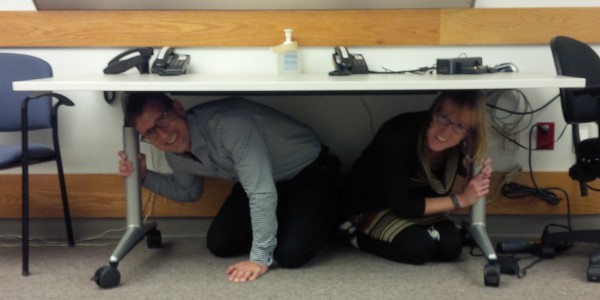Reminder: ShakeOut BC – October 15
On October 15th at 10:15 a.m., millions of people worldwide will practice how to Drop, Cover and Hold On during the Great British Columbia ShakeOut Earthquake Drill!
Earthquakes are common in BC and when the inevitable happens, your life will depend on whether you know the proper earthquake safety procedures.
What to do if the ground starts shaking?
If you are indoors:
1. STAY INSIDE. Running outside could put you at further risk for injury
2. DROP down onto your hands and knees. Shaking can be so strong that you will not be able to move far. Injuries can be avoided if you drop to the ground before the earthquake drops you.
3. COVER your head and neck (and body if possible) under a sturdy table or desk, and face away from windows. Most earthquake related injuries are caused by falling or flying objects (e.g. TVs, lamps, bookcases, etc).
• DO NOT find shelter under a doorway. Studies show it isn’t safe.
• If there is no table or desk nearby, crouch next to an interior wall and cover your head and neck with your arms. If available nearby, grab something to shield your head and face from falling objects and broken glass.
• If you are in bed, it is safer to hold on and stay there, protecting your head with a pillow.
• If you are in the kitchen, GET OUT immediately. The kitchen is one of the most dangerous places to be during an earthquake with plates, glass and cooking equipment flying out of cabinets.
• Elevator, If you are in an elevator when an earthquake happens, hit all floor buttons and get out as soon as the elevator doors open. If you’re trapped stay calm and try to get someone’s attention by tapping hard on metal parts of the structure.
• If you are in a crowded indoor place, do not rush for the doors. Move away from windows, skylights, heavy objects and display shelves containing objects that may fall. “Drop, Cover, and Hold On” still applies in this case, but watch that you do not get trampled.
• Stadium or Theater. Stay at your seat and protect your head and neck. Do not leave until the shaking is over. Walkout carefully watching for anything that could fall in the aftershocks.
4. HOLD ON to your shelter, and use the other hand to PROTECT YOUR HEAD, FACE, AND NECK until the shaking stops. If your desk or table has legs, hold on to it (several inches above the ground to avoid pinching). Be prepared to move with your shelter, it will likely move around significantly as the earth shakes.
5. When the shaking stops, remain in place and begin COUNTING ALOUD TO 60. This is an important step in order to account for any immediate aftershocks. It will not only calm you, but it will also allow for loose debris to finish falling.
If you are outdoors:
1. IMMEDIATELY get into an open area, away from trees, buildings, walls, and power lines. BE ALERT for flying debris. The area near the exterior walls of a building is the most dangerous place to be. Windows, facades, and architectural details are often the first parts of the building to collapse.
• If driving, pull your car to the side of the road and stop. Avoid overpasses, bridges, tunnels, power lines, light posts, trees, or large overhanging signs. Remain inside the car until the shaking stops.
• If you are in a Wheelchair, move to cover if possible, lock your wheels and protect your head with your arms.
Earthquakes strike without warning, so it is important to act now and get prepared!
Special discount offer
HEMBC has partnered with local emergency supplies vendor to offer PHC and VCH staff a 15% discount off any emergency kits ordered during September & October, 2015. Purchase your kits now using the following links:
• Braidner Survival Kits Ltd – use discount code: HEM02
• FAST Inc – use discount code: HEMBC
For more information on emergency procedures please visit the Health Emergency Management BC intranet page on VCH Connect.

